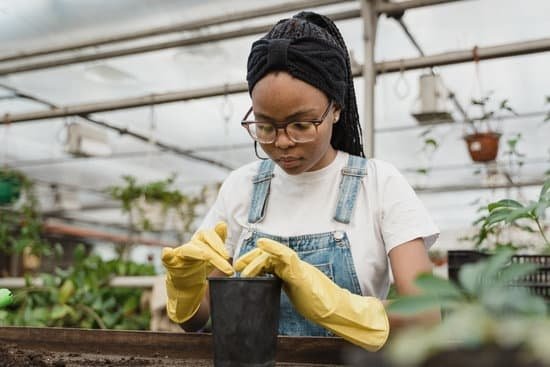Are you looking for creative indoor container gardening ideas to liven up your living space? Indoor container gardening is a great way to bring the beauty of nature indoors, even if you don’t have a lot of outdoor space.
In this article, we’ll explore the benefits of indoor container gardening, how to select the right containers and essential tools and supplies needed for success. We’ll also share some of the best plants to grow indoors and provide tips for maintaining and caring for your indoor container gardens.
Indoor container gardening is a popular and practical way to add greenery and life to any indoor environment. Whether you live in an apartment, condominium, or house, there are plenty of opportunities to create your own mini oasis inside. From herbs and flowers to vegetables and succulents, there are endless possibilities for what you can grow in your indoor garden.
and explore the exciting world of bringing the outdoors in through indoor container gardening. Whether you’re a seasoned gardener or just starting out, there’s something here for everyone who wants to enjoy the beauty of plants within their home.
Benefits of Indoor Container Gardening
Indoor container gardening offers a host of benefits for those looking to bring a little greenery into their homes without sacrificing valuable space. From improving air quality to providing a source of fresh herbs and vegetables, there are numerous advantages to cultivating plants indoors. Understanding the benefits of indoor container gardening can help you make the most of your indoor garden and create an environment that thrives.
Air Quality Improvement
One of the major benefits of indoor container gardening is the improvement it can bring to the air quality in your home. Houseplants have been proven to help remove toxins from the air, including formaldehyde and benzene, creating a healthier living environment for you and your family. With the right selection of plants and containers, you can enjoy cleaner, fresher air inside your home.
Mental Well-Being
In addition to its physical health benefits, indoor container gardening can also contribute to improved mental well-being. Studies have shown that spending time around plants can reduce stress, boost mood, and even increase productivity. Cultivating an indoor garden provides a source of relaxation and enjoyment, offering a peaceful escape from the stresses of daily life.
Creative Expression
Indoor container gardening also provides an opportunity for creative expression within your home. Whether you choose to set up a small herb garden in your kitchen or create a lush display of tropical plants in your living room, indoor gardening allows you to showcase your personal style and create a unique atmosphere in any space. By selecting the right containers, plants, and accessories, you can transform any room into a vibrant oasis that reflects your individual taste and preferences.
Selecting the Right Containers for Indoor Gardening
Material
When choosing containers for indoor gardening, consider the material that best suits your needs. Terracotta pots are a classic option known for their ability to absorb excess moisture, making them ideal for plants that require well-draining soil. Plastic pots are lightweight and come in various sizes and colors, making them a versatile choice for indoor container gardening. Fabric grow bags offer excellent air circulation to the roots of plants and are especially suitable for growing vegetables and herbs indoors.
Size
The size of the container is an important factor to consider when selecting containers for indoor gardening. Larger containers allow for more soil volume and root space, which is beneficial for plants with deep root systems or those that require more room to grow. Smaller containers are suitable for compact plants or herbs, making them ideal for small spaces such as windowsills or countertops.
Drainage
Proper drainage is essential for the health of your indoor plants. Ensure that your chosen containers have drainage holes at the bottom to prevent water from pooling at the roots, which can lead to root rot and other issues. If you fall in love with a container that lacks drainage holes, you can add them yourself using a drill or hammer and nails.
Consider these factors when selecting containers for your indoor garden to ensure optimal conditions for your plants’ growth and health. By carefully choosing the right containers, you can create a harmonious and visually appealing indoor garden filled with thriving greenery and flourishing blooms.
Essential Tools and Supplies for Indoor Container Gardening
Indoor container gardening is a popular and convenient way to bring nature into your home, especially if you have limited outdoor space. To get started with your own indoor garden, it’s important to have the right tools and supplies on hand. Here are some essential items you will need for successful indoor container gardening:
- Containers: When it comes to indoor container gardening, the type of containers you use can make a big difference. Choose containers that are the right size for the plants you want to grow and have proper drainage holes. Options include traditional clay pots, plastic containers, or decorative planters.
- Potting mix: A good quality potting mix is essential for indoor container gardening. Look for a mix that provides good drainage and aeration for plant roots. Make sure it is appropriate for the types of plants you plan to grow.
- Watering can or spray bottle: Proper watering is crucial for indoor plants. Depending on the size of your indoor garden, you may need a small watering can or a spray bottle to water your plants effectively.
- Pruning shears: Regular pruning helps keep your indoor plants healthy and encourages growth. Invest in a pair of pruning shears specifically designed for indoor plants to help maintain their health and appearance.
- Fertilizer: Indoor container gardens may benefit from periodic fertilization to ensure that plants receive adequate nutrients. Choose a fertilizer specifically formulated for indoor plants and follow the instructions carefully.
By having these essential tools and supplies on hand, you’ll be well-prepared to start your own indoor container garden and create a thriving green oasis within your home. Whether you’re a beginner or an experienced gardener, having these items will set you up for success with your indoor gardening endeavors.
Best Plants to Grow Indoors in Containers
When it comes to indoor container gardening ideas, choosing the right plants is essential for a successful and thriving garden. Not all plants are suitable for growing indoors, so it’s important to select varieties that are well-suited for indoor environments.
Some of the best plants to grow indoors in containers include herbs like basil, mint, and parsley, as well as leafy greens such as lettuce, spinach, and kale. These plants are relatively low-maintenance and can thrive in the controlled environment of an indoor space.
In addition to herbs and leafy greens, flowering plants like orchids, African violets, and peace lilies also make great choices for indoor container gardening. These plants add a pop of color and beauty to any indoor space while providing the added benefit of purifying the air. Succulents and cacti are also popular options for indoor container gardens due to their unique shapes and low water requirements.
One important factor to consider when choosing plants for indoor container gardening is the amount of light available in your indoor space. While some plants thrive in bright sunlight, others prefer lower light conditions. It’s essential to research the specific light requirements of each plant to ensure they will receive adequate sunlight for healthy growth. By selecting the right combination of plants based on light needs, you can create a diverse and visually appealing indoor garden.
| Plants | Light Requirements |
|---|---|
| Basil | Bright sunlight |
| African violets | Indirect light |
| Succulents | Bright sunlight or indirect light |
Creative Indoor Container Gardening Ideas for Small Spaces
If you live in a small apartment or have limited outdoor space, you can still enjoy the benefits of gardening by creating an indoor container garden. Here are some creative indoor container gardening ideas for small spaces:
- Vertical Gardens: Utilize vertical space by installing shelves, hanging planters, or wall-mounted containers to grow herbs, flowers, or small vegetables. This not only maximizes space but also adds a decorative touch to your home.
- Succulent Terrariums: Create a beautiful and low-maintenance indoor garden using glass terrariums and a variety of succulent plants. Place them on windowsills or tabletops to add a touch of greenery to any room.
- Window Box Gardens: If you have limited floor space, consider installing window boxes on the exterior or interior of your windows. This allows you to grow herbs, lettuce, or flowers without taking up valuable space.
In addition to these ideas, you can also consider using unusual containers such as old teacups, tin cans, or mason jars to bring a unique and personal touch to your indoor garden. Be sure to choose plants that are suitable for the amount of natural light available in your home and consider using a mix of different container sizes and shapes to create visual interest.
With these creative indoor container gardening ideas for small spaces, you can transform even the tiniest living quarters into a lush and vibrant oasis. Whether you’re looking to grow herbs for cooking, brighten up your home with colorful blooms, or simply enjoy the soothing presence of plants, there are plenty of options for creating an indoor garden that suits your style and space constraints.
Tips for Maintaining and Caring for Indoor Container Gardens
When it comes to indoor container gardening, maintenance and care are crucial to ensure the success of your plants. One important aspect of maintaining indoor container gardens is watering. It’s essential to water your plants regularly, but be mindful not to overwater them as this can lead to root rot. The frequency of watering will depend on the type of plant, the size of the container, and the environmental conditions within your home.
In addition to watering, fertilizing your indoor plants is also necessary for their growth and health. Select a high-quality fertilizer suitable for the specific types of plants you are growing indoors. Follow the instructions provided with the fertilizer to ensure you are not overfeeding your plants. Over-fertilization can lead to nutrient build-up in the soil and cause damage to your plants.
Another important aspect of maintaining indoor container gardens is ensuring adequate light exposure for your plants. Different plant species have varying light requirements, so it’s crucial to place them in areas where they can receive the appropriate amount of light. Some indoor container gardening ideas for small spaces include using hanging planters near windows or placing plants on shelves closer to natural light sources.
By paying attention to these tips for maintaining and caring for indoor container gardens, you can enjoy a thriving indoor garden all year round. Remember that each plant variety may have specific care needs, so it’s essential to research and understand the requirements of your chosen plants before starting your indoor container garden project.
DIY Indoor Container Garden Projects for Beginners
Are you a beginner looking to start your very own indoor container garden? Fear not. There are plenty of easy, do-it-yourself projects that can help get you started on your indoor gardening journey. With just a few simple materials and some creativity, you can create unique and functional containers for your favorite plants.
One great DIY project for beginners is creating self-watering containers. These containers are perfect for busy individuals who may not have the time to water their plants every day. All you need is a plastic storage container, some cotton string, and a drill. By drilling a small hole in the lid of the container and threading the cotton string through it, you can create a simple wicking system that will keep your plants consistently watered.
Another fun and practical project is building your own vertical herb garden. Using materials like wooden pallets or hanging shoe organizers, you can create a space-saving garden that adds greenery and fresh herbs to your kitchen or living space. This project not only adds beauty to your home but also provides access to fresh herbs for cooking without taking up too much space.
For those with limited space, creating a hanging planter using macrame techniques can be both functional and aesthetically pleasing. By using materials like rope or twine, you can make your own stylish plant hanger that will allow you to hang multiple plants in any room of your home.
With these DIY indoor container gardening ideas for beginners, anyone can bring the beauty of nature into their homes while exercising their creativity and green thumbs. Whether it’s creating self-watering containers, vertical herb gardens, or macrame plant hangers, there are endless possibilities for starting an indoor container garden in even the smallest of spaces.
Conclusion
In conclusion, indoor container gardening opens up a world of possibilities for those who want to enjoy the benefits of gardening but have limited outdoor space. The flexibility and creativity that comes with indoor container gardening make it an appealing option for anyone looking to add some greenery to their living spaces. By utilizing the right containers, tools, and plants, individuals can create beautiful and functional indoor gardens that enhance their homes.
Exploring the possibilities of indoor container gardening also provides numerous benefits beyond just adding visual appeal to a space. It allows individuals to grow their own fresh herbs, vegetables, and even flowers regardless of the season or climate. Additionally, indoor container gardening has been shown to provide mental health benefits by reducing stress and anxiety while also improving air quality within a home.
For those interested in starting their own indoor container garden, there are plenty of creative ideas for small spaces that can be implemented. From using vertical space to incorporating hanging planters, there are numerous ways to maximize limited space for gardening.
Moreover, engaging in DIY projects is a great way for beginners to get involved in indoor container gardening and personalize their living space with unique plant displays. Overall, the possibilities are endless when it comes to bringing the beauty of nature indoors through container gardening.
Frequently Asked Questions
What Is the Best Container to Grow Vegetables Indoors?
The best container to grow vegetables indoors is one with good drainage, proper size, and enough space for the vegetable’s roots to grow. It can be a pot, planter, or even a repurposed container as long as it meets the plant’s needs.
What Can You Put in an Indoor Planter?
Indoor planters can hold a variety of plants such as herbs, flowers, succulents, or even small vegetables. It’s important to consider the plant’s specific needs like sunlight, humidity, and root space when choosing what to put in an indoor planter.
What Do You Fill an Indoor Planter With?
When filling an indoor planter, it’s essential to use high-quality potting soil that provides nutrients and proper drainage for the plants. Some gardeners also add perlite or vermiculite to improve water retention and aeration in the soil mix for better growing conditions.

Welcome to my gardening blog! I am passionate about plants and enjoy sharing my knowledge and experiences with others. In this blog, I will write about everything related to gardening, from tips on how to get started to updates on my own garden projects.





